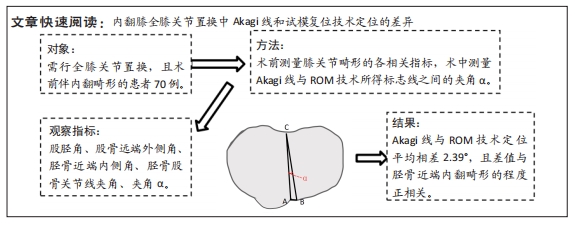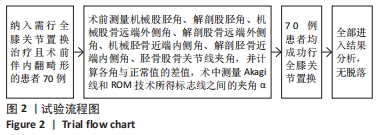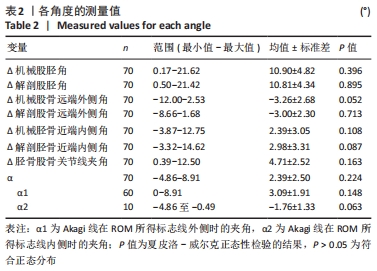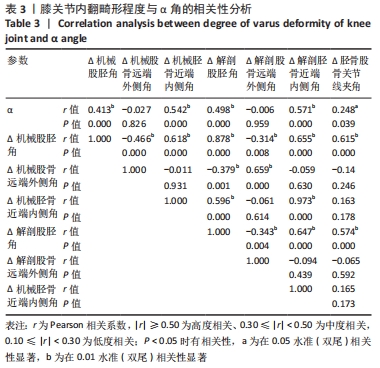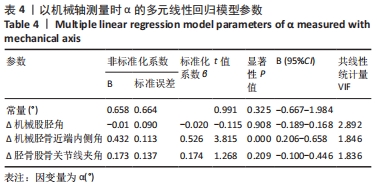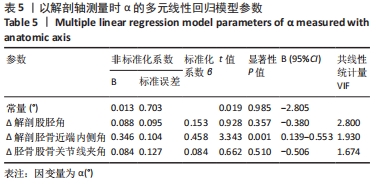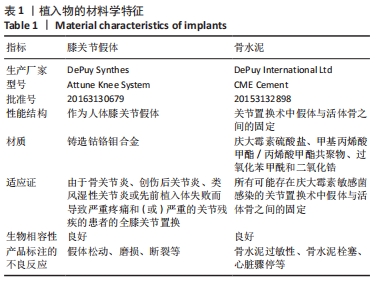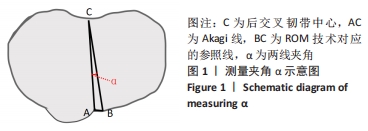[1] PRICE AJ, ALVAND A, TROELSEN A, et al. Knee replacement. Lancet. 2018;392(10158):1672-1682.
[2] MATZ J, LANTING BA, HOWARD JL. Understanding the patellofemoral joint in total knee arthroplasty. Can J Surg. 2019;62(1):57-65.
[3] TANIKAWA H, TADA M, OGAWA R, et al. Influence of Patella thickness on Patellofemoral pressure in total knee Arthroplasty. BMC Musculoskelet Disord. 2021;22(1):298.
[4] PUTMAN S, BOUREAU F, GIRARD J, et al. Patellar complications after total knee arthroplasty. Orthop Traumatol Surg Res. 2019;105(1S): S43-S51.
[5] DONELL S. Patellar tracking in primary total knee arthroplasty. EFORT Open Rev. 2018;3(4):106-113.
[6] 李向平,胡淼,李勇军. 血清D-二聚体和炎症指标单独及联合检测对髋、膝关节置换术后假体周围感染的诊断价值[J]. 新乡医学院学报,2021,38(4):337-340.
[7] 宗雅琪,刘嵬,张英剑,等. 性别、吸烟和BMI对髋膝关节置换术后假体无菌性松动的影响[J]. 透析与人工器官,2021,32(3):32-34.
[8] 姜灵凯,魏垒,董政权,等.活动平台与固定平台单髁置换治疗内侧膝骨关节炎的Meta分析[J]. 中国骨伤,2022,35(1):67-75.
[9] 耿天翔. 雷尼酸锶通过Wnt/β-Catenin通路抑制磨粒诱导无菌性松动的动物实验研究[D]. 银川:宁夏医科大学,2018.
[10] 牛舜. 颗粒诱导人工关节无菌性松动机理的研究、药物复合涂层假体的制备及其对假体松动的预防作用[D].西安:第四军医大学, 2012.
[11] 高昭,赵宇昊,何易祥,等. Marlex网片在全膝关节置换术后伸肌装置受损治疗中的研究进展[J].实用骨科杂志,2022,28(3):234-237.
[12] 吾米提·塔西,刘爱峰,纪能能,等.全膝关节置换术中胫骨假体旋转对线研究进展[J].中华外科杂志,2022,60(3):268-272.
[13] SAFFARINI M, NOVER L, TANDOGAN R, et al. The original Akagi line is the most reliable: a systematic review of landmarks for rotational alignment of the tibial component in TKA. Knee Surg Sports Traumatol Arthrosc. 2019;27(4):1018-1027.
[14] FANG CH, CHENG CK, QU TB, et al. The Posterolateral Corner-Locked Technique Is Applicable in a Chinese Population Regarding the Tibial Component Rotation Alignment in Total Knee Arthroplasty. J Knee Surg. 2020;33(5):466-473.
[15] POPESCU R, HARITINIAN EG, CRISTEA S. Methods of intra- and post-operative determination of the position of the tibial component during total knee replacement. Int Orthop. 2020;44(1):119-128.
[16] ROSSI R, BRUZZONE M, BONASIA DE, et al. Evaluation of tibial rotational alignment in total knee arthroplasty: a cadaver study. Knee Surg Sports Traumatol Arthrosc. 2010;18(7):889-893.
[17] KAWAGUCHI K, INUI H, YAMAGAMI R, et al. A new technique for determining the rotational alignment of the tibial component during total knee arthroplasty. Knee. 2021;29:323-331.
[18] ECKHOFF DG, JOHNSTON RJ, STAMM ER, et al. Version of the osteoarthritic knee. J Arthroplasty. 1994;9(1):73-79.
[19] ECKHOFF DG, METZGER RG, VANDEWALLE MV. Malrotation associated with implant alignment technique in total knee arthroplasty. Clin Orthop Relat Res. 1995;(321):28-31.
[20] KIM JI, JANG J, LEE KW, et al. Anterior tibial curved cortex is a reliable landmark for tibial rotational alignment in total knee arthroplasty. BMC Musculoskelet Disord. 2017;18(1):252.
[21] SAFFI M, SPANGEHL MJ, CLARKE HD, et al. Measuring Tibial Component Rotation Following Total Knee Arthroplasty: What Is the Best Method? J Arthroplasty. 2019;34(7S):S355-S360.
[22] MA Y, MIZU-UCHI H, USHIO T, et al. Bony landmarks with tibial cutting surface are useful to avoid rotational mismatch in total knee arthroplasty. Knee Surg Sports Traumatol Arthrosc. 2019;27(5):1570-1579.
[23] 李叶天,刘富恩,尹力,等.膝关节置换中以ROM技术定位胫骨假体的旋转力线[J].中国组织工程研究,2020,24(24):3840-3845.
[24] 陶坤,吴宇黎,祝云利,等.全膝关节置换术中胫骨假体旋转确定方法的比较研究[J].中国骨与关节损伤杂志,2009,24(4):301-304.
[25] 刘欣. 初次全膝关节置换术中两种胫骨假体旋转对线方法的对比研究[D].太原:山西医科大学,2020.
[26] 胡鸿鹏,高勇岗,刘泽明,等.膝关节骨关节炎患者膝关节内翻畸形与胫骨旋转角关系的临床研究[J].中华老年骨科与康复电子杂志,2019,5(2):99-104.
[27] PANNI AS, ASCIONE F, ROSSINI M, et al. Tibial internal rotation negatively affects clinical outcomes in total knee arthroplasty: a systematic review. Knee Surg Sports Traumatol Arthrosc. 2018;26(6): 1636-1644.
[28] ROUSSOT MA, VLES GF, OUSSEDIK S. Clinical outcomes of kinematic alignment versus mechanical alignment in total knee arthroplasty: a systematic review. EFORT Open Rev. 2020;5(8):486-497.
[29] 金焱. 华南人群OA患者与健康人群胫骨旋转对位研究[D].广州:南方医科大学,2021.
[30] OHMORI T, KABATA T, KAJINO Y, et al. A proposed new rotating reference axis for the tibial component after proximal tibial resection in total knee arthroplasty. PLoS One. 2018;13(12):e0209317.
[31] 史博,孙振辉,杨涛,等.内翻型膝关节骨性关节炎患者胫股关节扭转和胫骨假体旋转定位研究[J].中国矫形外科杂志,2013,21(23): 2339-2344.
[32] 窦勇,周一新,柳剑,等. 基于Akagi轴线对膝骨关节炎患者胫骨旋转参考轴线的相关研究[J]. 中国矫形外科杂志,2015,23(2):97-101.
[33] 余华晨,温宏,张宇,等. Akagi线作为全膝关节置换胫骨近端假体旋转对线的可靠性研究[J]. 中国骨伤,2015,28(10):884-887.
[34] 路玉峰,任小宇,郝阳泉,等.胫骨前嵴作为全膝关节置换术胫骨假体旋转对位解剖参考的可靠性研究[J]. 中国骨伤,2021,34(5): 417-424.
|
